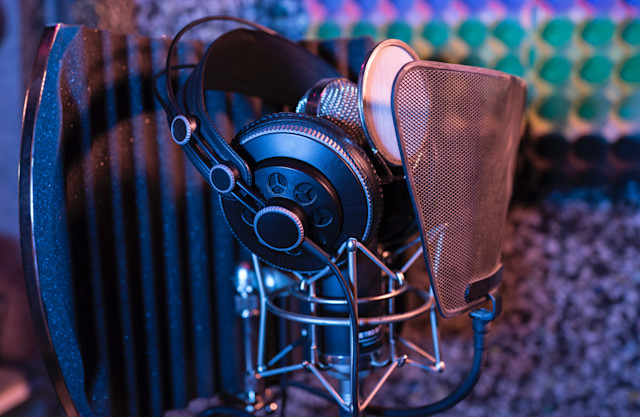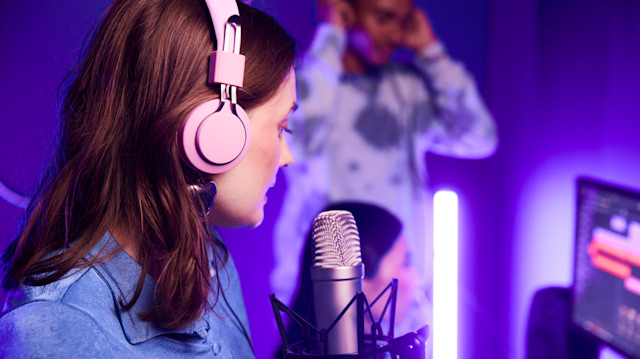7 Pro Tips to Get Flawless Vocal Recordings Every Time
October 27, 2023 / Anton Berner

Capturing flawless vocal recordings is a cornerstone of producing high-quality music, podcasts, or any form of audio content. The process of recording vocals, singing, rapping, and talking, demands meticulous attention to detail and a deep understanding of various technical aspects.
From setting up the recording environment to utilizing effective noise reduction techniques, each step plays a crucial role in achieving pristine vocal tracks that resonate with listeners.
In this 7-step guide, we delve into seven indispensable tips that can help you consistently achieve impeccable vocal recordings.
Whether you're a seasoned audio engineer or an aspiring recording artist, mastering these fundamental techniques will empower you to produce professional-level vocal tracks that captivate audiences with their pristine clarity and captivating sound quality.
Discover the art of creating stunning vocal recordings that reflect the true essence and emotion of the performance, and take your vocal production to new heights.
1. Choose the right recording environment for vocals
Creating an optimal recording environment is essential for capturing flawless vocal recordings. To achieve this, consider the following key factors:
Firstly, invest in acoustic treatment such as soundproofing materials or acoustic panels to minimize unwanted reflections and external noises.
Additionally, ensure proper isolation within the recording space by using isolation shields or vocal booths to prevent sound leakage and external disturbances.
Moreover, select a location with minimal background noise to maintain a quiet atmosphere during recording. The removal of background noise can be done in the mixing stage with tools like Soundtrap’s Vocal Cleanup (Powered by AI), but it’s obviously best to eliminate any disturbing noise at the recording stage.
Furthermore, pay attention to proper ventilation and temperature control within the recording space to keep the vocalist comfortable and prevent any unwanted background sounds generated by cooling or heating systems.
Maintaining a consistent and comfortable environment can contribute to a more relaxed and focused vocal performance. By prioritizing these aspects, you can create an ideal setting for flawless vocal recordings, allowing the vocalist's true talent and expression to shine through in every take.

Creating an optimal recording environment is key to capture flawless vocals
2. Prepare the vocalist before hitting “record”
Preparing the vocalist before recording is crucial for ensuring an impactful and seamless vocal performance. To achieve this, focus on the following key aspects:
Firstly, encourage the vocalist to engage in vocal warm-ups and exercises to relax vocal muscles, improve breath control, and enhance vocal flexibility. Adequate hydration is also vital to maintain vocal cord lubrication and prevent strain during recording. Recommend avoiding excessive caffeine and alcohol consumption, and emphasize vocal care practices to prevent potential vocal fatigue or damage.
Secondly, emphasize the importance of understanding the lyrics and emotional nuances of the song. Guiding the vocalist to interpret the lyrics and express the intended emotions effectively can lead to a more authentic and heartfelt performance.
By prioritizing these preparatory steps, you can ensure that the vocalist is in the best possible condition to deliver a compelling and captivating performance during the recording session.
3. Choose the right microphone for the vocalist
Choosing the ideal microphone for vocal recordings involves key considerations to ensure optimal sound quality and performance.
Begin by understanding the various microphone types, such as dynamic, condenser, or ribbon, and select one that complements the unique qualities of the vocalist's voice and the desired recording style.
Additionally, assess the microphone's polar pattern, whether cardioid, omnidirectional, or figure-8, to effectively manage off-axis sound rejection and capture the desired vocal directionality.
Evaluate the microphone's frequency response to ensure it accurately captures the vocal range, including delicate highs and rich lows. Look for a balanced frequency response that faithfully reproduces the nuances of the vocalist's performance.
Consider the microphone's sensitivity to sound pressure levels to prevent distortion during dynamic vocal passages. Taking into account your budget and the specific recording environment, choose a microphone that aligns with your financial constraints while also considering the acoustic characteristics of the recording space.
By carefully considering these factors, you can select a microphone that enhances the vocalist's performance, capturing the subtle nuances and emotions with exceptional clarity and fidelity.
Read more: Mic Check, One-Two: Choosing the Right Microphone for Instrument Recording

Select a microphone that enhances the vocalist's performance
4. Control your cables when setting up the mic
Before you start recording vocals, it's crucial to check your cables for any signs of damage or wear, ensuring they're in optimal condition.
Look for frayed wires, loose connectors, or any visible issues, addressing them beforehand to prevent any signal loss or interruptions during the recording process. Confirm the stability of the cable connections, ensuring they are securely plugged in and unlikely to disconnect during the session.
Additionally, test the cables by sending a signal through them to identify any potential distortions or interruptions, allowing you to resolve any underlying issues before you begin recording, ensuring a smooth and uninterrupted vocal recording session.
5. Make sure the microphone is optimally positioned
Positioning the microphone optimally is crucial for capturing clear and dynamic vocal recordings. Follow these essential tips to ensure the microphone is correctly placed before you start recording:
Distance and Angle: Maintain an optimal distance between the vocalist and the microphone to capture a balanced sound without distortion. Position the microphone at a slight angle, pointing towards the vocalist's mouth, to capture the best tonal quality and minimize any unwanted background noise or plosives.
Microphone Height: Adjust the microphone's height to match the vocalist's mouth level, ensuring consistent sound projection and preventing any potential loss of audio clarity. Find the ideal balance to capture the full vocal range while minimizing the impact of any handling noise or vibrations that could affect the recording quality.
By carefully positioning the microphone to suit the vocalist's voice and style, you can achieve pristine vocal recordings that showcase the full depth and richness of the performance.
6. Control the input signal a.k.a gain staging
Managing the input signal, also known as gain staging, is a critical step in ensuring high-quality vocal recordings. Proper gain staging helps maintain a clean and balanced audio signal, preventing any unwanted distortion or clipping. Follow these fundamental guidelines to effectively control the input signal during vocal recording:
Set Initial Levels: Begin by setting the initial input levels on your audio interface or preamp. Aim for a moderate level that allows the vocalist's dynamic range to be captured without peaking or clipping. Keep a close eye on the signal meter to ensure the input levels remain within the safe range.
Monitor Throughout Recording: Continuously monitor the input signal levels as the vocalist performs. Adjust the gain accordingly to accommodate any variations in vocal intensity, ensuring that the signal remains consistent and free from any unexpected spikes or drops.
By mastering the art of gain staging, you can maintain an optimal input signal level throughout the vocal recording process, resulting in professional-quality recordings that showcase the full emotional range and nuances of the vocal performance.
7. Use noise reduction to clean up the recording
Implementing effective noise reduction techniques can significantly enhance the clarity and quality of your vocal recordings. Here's how to use noise reduction to refine and clean up your vocal tracks:
Identify Problematic Areas: Listen attentively to the recording and pinpoint any unwanted background noise, hiss, or hum that may be affecting the vocal track. Take note of these areas for targeted noise reduction.
Apply Soundtrap’s Vocal Cleanup (Powered by AI): Soundtrap’s vocal noise reduction tool allows you to eliminate any disturbance in the vocal recording with the click of a button. The tool’s AI technology automatically identifies the noise disturbance and effectively removes it without any negative impact on the vocal signal. Simply right-click on the vocal region you want to edit and apply the Vocal Cleanup tool from the drop-down.
By employing Soundtrap’s vocal noise reduction, you can elevate your vocal recordings to a professional standard, creating a polished and immersive audio experience for your audience.
About the author
Anton Berner is a music producer, audio engineer, and songwriter from Stockholm, Sweden. He's produced hip-hop & rap music since the early 2000s and his expertise is in vocal mixing and sample-based beat production. Anton is also the SEO & Content Manager @ Soundtrap and manages the blog and newsroom.
Soundtrap — the online music studio
Making music is more than just a hobby — it’s a form of self-expression, a way to unleash your creativity, and a means for you to bring your unique voice to the world.
Soundtrap is the ultimate audio production software for music makers and producers to easily collaborate and create music online, with thousands of audio loops, instruments, and samples only a click away.
Get started with Soundtrap today!